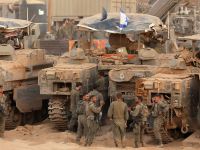Enaam Khaled is a passionate photographer of traditional houses. For years, she has been documenting Beirut’s old buildings, especially those located in the historic neighbourhoods of Gemmayze and Mar Mikhail, the two worst hit areas from the seismic blast that rocked the city on August 4.
“People are calling on me to have the photos I have taken of their houses so that they can restore them to what they were,” said Khaled, who is also a founding member of Beirut Heritage, a local NGO struggling to preserve Beirut’s old buildings
“For years, I have been taking photos and collecting data of these houses which if they are lost will take away Beirut’s identity, its Levantine face and social fabric,” Khaled said.
“The first day after the explosion I was in the street. I just could not believe what I saw. It was an apocalyptic scene. I could not hold back my tears. I felt my heart was shattered into pieces just like the glass windows. I could not take photos of the devastation…. That was not my Beirut,” she said.
Beirut Heritage and other heritage conservationist groups have joined hands to save what is left of Beirut’s architectural heritage wrecked by decades of wars, chaotic development and the latest blast caused by the ignition of more than 2,750 tons of ammonium nitrate improperly stored for years in Beirut port.
The explosion created a pressure wave that ripped through the capital, killing more than 200 people and injuring about 6,000. It also damaged some 8,000 houses, leaving more than 300,000 people homeless.
Around 600 historic buildings were damaged, including many structures at risk of collapse.
The damaged buildings include old homes, museums, religious sites and cultural landmarks like Sursock Museum.
After the blast, Beirut Heritage set up a “crisis cell” of volunteer professionals, including architects, engineers and contractors, to assess the damages, secure funds and help in the restoration effort.
“We are coordinating the work with the Directorate General of Antiquities,” Khaled said. “We divided the damaged areas into zones, and each NGO was assigned to assess the damage sustained in a specific zone.”
“The majority of the buildings can be restored. They are not a total loss and as long as there is awareness and determination to preserve them they can be saved. We will not allow what happened in Solidere to be repeated in Mar Mikhail and Gemayzeh,” she added.
Solidere is the company that was in charge of rebuilding Beirut’s downtown, which was ravaged by 15 years of civil war. Instead of having historic buildings that remained standing refurbished, hundreds initially designated for restoration were razed, with no laws to stop the destruction. They were replaced by high-rise towers, luxury apartments and high-end stores meant more for wealthy Gulf tourists than for locals.
Palais Sursock, a 150-year-old residence in the neighborhood of Ashrafieh, is among the architectural jewels classified by the culture ministry as part of the national heritage. Its facades were severely damaged by the blast and might collapse, the interior was totally ravaged and many of the collection pieces lost forever.
“The palace is located about 500 meters away from the explosion. It definitely needs to be saved because it is a landmark of Ashrafieh and part of Beirut’s history. It lived through the Ottoman period, the French period and the civil war,” said Roderick Sursock Cochrane, whose great grandfather built the palace in 1870.
“First we will be consolidating the building’s structures to make it safe again. In a later phase we will work on the interior but we will not do so until we know where Lebanon is going… And Lebanon is going nowhere unless Hezbollah disappears,” Cochrane said.
While rumours circulate about brokers preying on homeowners who cannot afford to repair their properties, conservationists now fear an onslaught of opportunistic developers ready to raze historic buildings and turn them into apartment blocks.
But Beirut Heritage and other groups have mobilised to combat unfettered redevelopment, with teams of volunteers assessing buildings’ structural integrity.
Volunteers from the Syndicate of Architects and Engineers have already consolidated the structures of 18 buildings in Gemmayzeh and Mar Mikhail as a prelude to restoration with the help of contractors who volunteered material and labour.
“Volunteers have been going around reassuring owners and tenants that they will get help to repair and that they are not alone in this fight. Also, a decree was issued preventing the sale of any historic building without the permission of the Directorate General of Antiquities,” Khaled said.
Throughout history, Beirut was destroyed several times in earthquakes or wars, but its people have always been able to rebuild it,” Khaled said.
“The time of weeping and crying is over. Now it is the time for work and reconstruction. We are determined to put our city back on its feet, remove its scars and restore its beautiful face and identity,” she added.
This article has been adapted from its original source.








